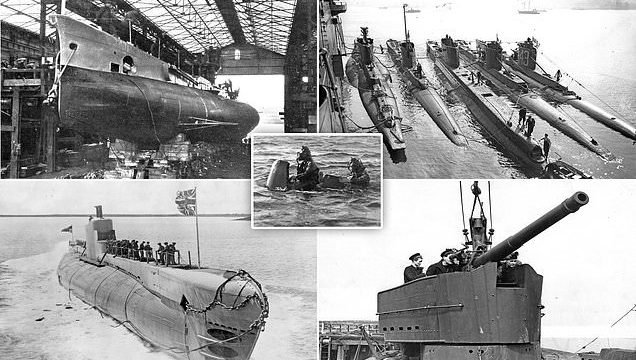Britain’s battle beneath the waves: The Royal Navy submarines and their fearless crews who played crucial role defending UK during the two world wars
- Fascinating photos of four submarines sitting side by side in Australian waters in 1945, a brave sailor manning a ‘midget’ submarine, and the cramped, stuffy control room where lives could be saved or lost
- The remarkable photos form part of acclaimed naval historian Norman Friedman’s British Submarines In Two World Wars, a hugely in-depth summary of the evolution of underwater conflict
- During the First World War British submarines virtually closed the Baltic to German iron ore traffic, and they helped block supplies to the Turkish army fighting at Gallipoli
A new book shows the crucial role British submarines played in the two world wars and the gruelling jobs that their crew undertook.
Fascinating photos of four submarines sitting side by side in Australian waters in 1945, a brave sailor manning a ‘midget’ submarine, and the cramped, stuffy control room where lives could be saved or lost.
The remarkable photos form part of acclaimed naval historian Norman Friedman’s British Submarines In Two World Wars, a hugely in-depth summary of the evolution of underwater conflict and its role in the greatest wars of the 20th century.
The claustrophobic control room of a First World War J-class submarine. The J-class were developed by the Royal Navy prior to the First World War and were much larger than previous British submarines
British submarine M 1 in camouflage. The wavy pattern helped make it less visible when it surfaced. The submarine sank in 1925 while on an exercise in the channel, and none of the crew survived. The wreck was discovered in 1999
This photo shows how newer submarines dwarfed their predecessors. Here an O-class submarine lies alongside M 2, L 25 and H 32, in descending size, with other O-class submarines forward of her
The Royal Navy’s J-class submarines in World War One (pictured). After the Great War they were given to the Royal Australian Navy who which could not afford to maintain and operate them, and soon had to discard them
HMS Venturer, the first (and so far the only) submarine to have sunk another submarine while both were submerged, in her case sinking a U-Boat off Norway on February 9 1945
Four T-class submarines lie alongside HMS Adamant in Fremantle, 1945. Their size was limited to keep the cost down. To provide sufficient firepower, they were given external torpedo tubes
‘The Royal Navy did not invent the submarine, but by 1914 it was the world’s leading submarine operator,’ explained Friedman.
‘It was extremely innovative. For example, it originated the specialised anti-submarine submarine which became so important after the Second World War.
‘Its First World War fleet submarines can be seen as forebears of modern fast nuclear submarines intended for direct support of battle groups.
‘By 1914 the Royal Navy considered submarines integral to its strategy. Like the rest of the Royal Navy’s ships, submarines were much affected by the strategic shifts of the interwar years, from an emphasis on European waters to the Far East and then back to European waters.
‘These shifts are visible in the design of British submarines.
‘The Royal Navy did not buy submarines until 1901 not because of some innate conservatism but because up to that point submarines did not affect its strategy. It kept close watch on foreign submarine developments, the question always being when (and if) submarines matured to the point that they might affect British naval operations.
‘Of course, in the end they did and by 1914 the UK had the largest submarine fleet in the world.
‘The First World War was the first submarine war. British submarines operated effectively in the North Sea, the Mediterranean and the Baltic. This experience shaped the interwar British submarine fleet. The service grew enormously after 1914. At that time it comprised 62 submarines, with 168 officers and 1250 enlisted men. On 11 November 1918 a total of 133 submarines were in commission and the service had grown to 444 officers and 4196 enlisted men.’
During the First World War British submarines virtually closed the Baltic to German iron ore traffic, and they helped block supplies to the Turkish army fighting at Gallipoli, preventing further loses during the Gallipoli disaster.
British submarines were a major element in the North Sea battles, and they helped fight the U-boat menace which was devastating allied forces shipping.
The lessons learnt in the First World War could be applied to British submarine operations in World War II.
‘Readers will be aware of the role of US submarines in strangling Japan, but perhaps not how British submarines in the Mediterranean fought a parallel costly but successful battle to strangle the German army in North Africa,’ continued Friedman.
‘Like their US counterparts, interwar British submariners were designed largely with the demands of a possible Pacific War, although that was not the war they fought.
‘Readers will see how the demands of such a war, which would be fought over vast distances, collided with interwar British Government attempts to limit costs by holding down the size (and numbers) of submarines.
‘It says much about the ingenuity of British submarine designers that they managed to meet their requirements despite enormous pressure on submarine size.’
During the Second World War the Royal Navy also operated both midget submarines and manned torpedoes (Chariots), tiny crafts which could operate stealthily and in utmost secrecy. They were designed to attack enemy submarines who were protected in heavily armoured harbours or even bridge supports.
Norman Friedman’s British Submarines In Two World Wars, published by Pen and Sword Books, is due for release next month.
Source: Read Full Article






